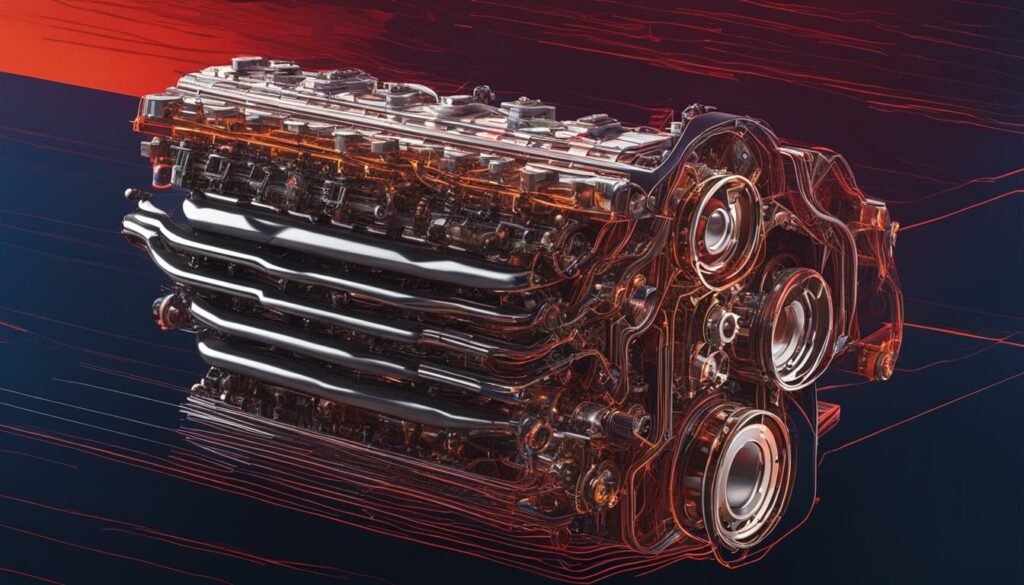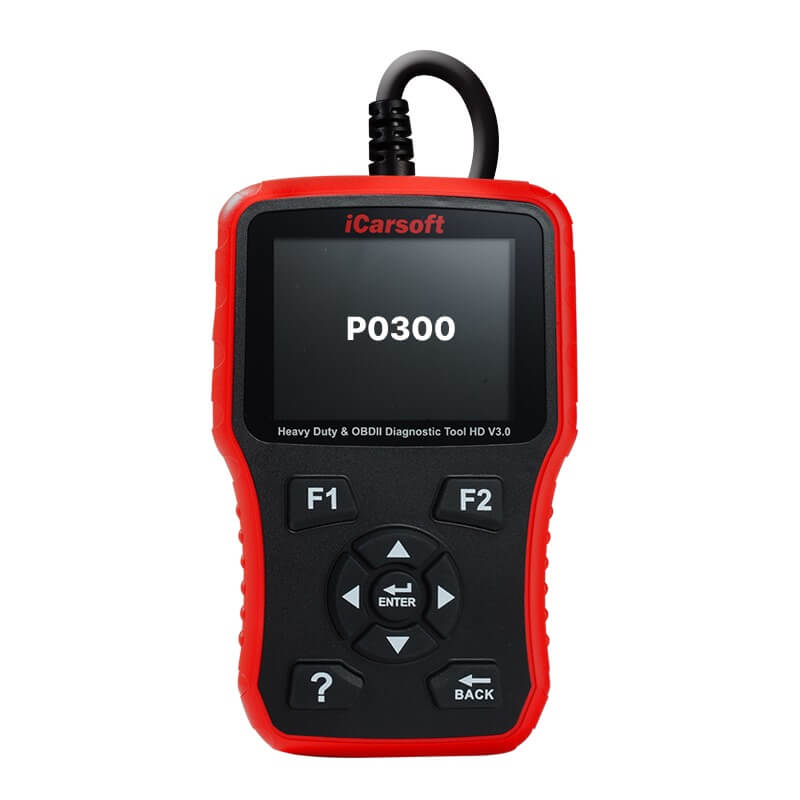P0300 – Random Multiple Cylinder Misfire
POSTED IN pcodes
When you encounter a P0300 trouble code, it means that your vehicle is experiencing misfiring in random or multiple cylinders. This issue arises when there is an inadequate amount of fuel being burned within a cylinder. In most cars, which typically have four to six cylinders, each cylinder fires a spark plug in a continuous and smooth manner. The spark plug ignites the fuel-air mixture inside the cylinder, ensuring proper combustion. However, if this process malfunctions, a misfire occurs.
If multiple cylinders misfire, the revolutions per minute of the crankshaft (RPM) will increase or decrease by more than 2%. When this happens, your car’s powertrain control module (PCM) activates and stores the P0300 code. Although it may be tempting to limp your way home or to the nearest mechanic, it is advisable to turn off your car immediately and call for assistance. Random misfires can cause damage not only to your engine but also to your catalytic converter, which is far more expensive to replace than getting your car towed to a mechanic. Our recommendation is to stop the car right away and have it towed.
Key Takeaways:
- A P0300 trouble code indicates random or multiple cylinder misfires.
- Misfires occur when there is a deficiency in fuel combustion within a cylinder.
- Ignoring the P0300 code can lead to engine damage and costly repairs.
- Common symptoms of a P0300 code include check engine light illumination, rough engine running, and increased fuel consumption.
- Common causes of a P0300 code include faulty spark plugs, ignition coils, fuel injectors, and vacuum leaks, among others.
What does the P0300 OBD-II code mean?
When a P0300 trouble code is triggered, it indicates that misfiring occurs in random or multiple cylinders. This happens when there is a deficient amount of fuel being burned within a cylinder. The code does not specify the exact cylinders that are misfiring, only that there is a general misfire happening. The severity of the P0300 code can vary depending on the cause and how long the issue has been present. It is important to address this code as soon as possible to prevent any further damage to the engine.
Technical Description
A P0300 code is part of the OBD-II system, which stands for On-Board Diagnostics. It is a standardized system used by vehicles to self-diagnose and report any issues or malfunctions. The P0300 code specifically relates to a random or multiple cylinder misfire within the engine. Misfiring occurs when the air-fuel mixture in a cylinder fails to ignite properly, leading to a loss of power and potential damage to the engine.
Meaning and Severity
The P0300 code indicates that there is a general misfire happening in random or multiple cylinders. This could be caused by a number of factors such as faulty spark plugs, ignition coils, fuel injectors, or vacuum leaks. It is important to address this code promptly as it can lead to further damage to the engine if left unresolved.
Buy tested tuning file for Adblue / EGR / DPF / Adblue off now!
Misfire Repair
The repair process for a P0300 code involves diagnosing and fixing the underlying cause of the misfire. This typically includes inspecting and replacing spark plugs, ignition coils, and fuel injectors if necessary. Additionally, any vacuum leaks need to be identified and repaired. It is recommended to consult a professional mechanic for an accurate diagnosis and proper repair of the issue.
| Component | Possible Causes |
|---|---|
| Spark Plugs | Worn, faulty, or damaged spark plugs |
| Ignition Coils | Defective or damaged ignition coils |
| Fuel Injectors | Defective or stuck open fuel injectors |
| Vacuum Leaks | Leaks in the vacuum system |
How serious is the P0300 code?
If you see the P0300 diagnostic code on your vehicle, it is important to understand that it should be considered a serious problem. Misfire symptoms associated with this code, such as rough engine running and increased fuel consumption, can indicate underlying issues that require immediate attention.
In particular, the P0300 code can lead to fatal damage to the catalytic converter(s) if left unresolved. The catalytic converter plays a crucial role in reducing harmful emissions from the exhaust system. When multiple cylinders misfire, unburned fuel can enter the catalytic converter and cause overheating, leading to irreparable damage. To avoid costly repairs, it is essential to address the P0300 code promptly.
Furthermore, ignoring the P0300 code can potentially lead to more severe engine damage. Misfiring causes unburned fuel to enter the exhaust system, which can result in damage to engine components like the piston rings, valves, and cylinder walls. These repairs can be costly and time-consuming, so it is crucial to take the P0300 code seriously and resolve it as soon as possible.

What are the common symptoms of a P0300 trouble code?
The P0300 OBD-II code is associated with a random multiple cylinder misfire. Detecting and addressing this code promptly is crucial to prevent further damage to your vehicle. Here are the most common symptoms to look out for:
- Check engine light: The check engine light may illuminate or flash when a P0300 code is present. If the light is flashing, it indicates a more serious misfiring issue.
- Vehicle starting issues: You may experience difficulty starting your vehicle, or it may not start at all.
- Rough engine running: The engine may run rough, causing vibrations and an overall poor driving experience.
- Increased fuel consumption: You may notice that your vehicle’s fuel consumption has increased, resulting in more frequent trips to the gas station.
- Engine cutting out: The engine may cut out intermittently while driving, leading to potential safety concerns.
- Hesitant acceleration: When you try to accelerate, the engine may hesitate and feel sluggish.
- Fluctuating idling speed: The engine’s idling speed may fluctuate or not remain stable, causing an unstable idle.
If you experience any of these symptoms along with a P0300 code, it is essential to address the issue promptly. Ignoring the problem could lead to further engine damage and potentially costly repairs in the future.
| Symptom | Description |
|---|---|
| Check engine light | The check engine light may illuminate or flash when a P0300 code is present. If the light is flashing, it indicates a more serious misfiring issue. |
| Vehicle starting issues | You may experience difficulty starting your vehicle, or it may not start at all. |
| Rough engine running | The engine may run rough, causing vibrations and an overall poor driving experience. |
| Increased fuel consumption | You may notice that your vehicle’s fuel consumption has increased, resulting in more frequent trips to the gas station. |
| Engine cutting out | The engine may cut out intermittently while driving, leading to potential safety concerns. |
| Hesitant acceleration | When you try to accelerate, the engine may hesitate and feel sluggish. |
| Fluctuating idling speed | The engine’s idling speed may fluctuate or not remain stable, causing an unstable idle. |
What are the causes of a P0300 diagnostic code?
When a P0300 diagnostic code is triggered, it indicates that there is a misfire happening in random or multiple cylinders. This could be caused by a variety of factors that affect the ignition system, fuel delivery, or engine components. Understanding the possible causes can help in diagnosing and resolving the issue.
- Spark plugs: Faulty, damaged, or worn spark plugs can lead to improper combustion, resulting in a misfire. Inspecting and replacing spark plugs at regular intervals is crucial to prevent this issue.
- Ignition coils: Defective, damaged, or corroded ignition coils or their connectors can disrupt the electrical flow and cause misfires. Inspecting and replacing faulty ignition coils can help resolve the problem.
- Fuel injectors: Stuck open or defective fuel injectors can cause an imbalance in fuel delivery to the cylinders, leading to misfires. Testing and repairing or replacing faulty fuel injectors is necessary.
- EGR valves: Defective EGR valves or clogged tubes can disrupt the combustion process, resulting in misfires. Cleaning or replacing EGR valves and clearing any blockages can help resolve the issue.
- Vacuum leaks: Leaks in the intake manifold or vacuum hoses can cause an imbalance in air-fuel mixture, leading to misfires. Identifying and repairing vacuum leaks is essential to prevent this problem.
- Head gasket: A leaking head gasket can affect the combustion process and cause misfires. Repairing or replacing the faulty head gasket is necessary to resolve the issue.
- Catalytic converter: A clogged or faulty catalytic converter can restrict the exhaust flow and increase back pressure, leading to misfires. Inspecting and replacing a faulty catalytic converter is crucial.
- Other possible causes: Additional factors that can trigger a P0300 code include low fuel pressure, a cracked distributor cap, defective camshaft or crankshaft sensors, faulty mass air flow sensor, defective oxygen sensor, faulty throttle position sensor, and a faulty powertrain control module (PCM).
Diagnosing the specific cause of the P0300 code may require further testing and inspection to pinpoint the issue accurately. Understanding these potential causes can help guide the diagnostic process and ensure the appropriate repairs are made to resolve the misfire problem.

How to diagnose and fix a P0300 OBD-II trouble code?
Diagnosing and fixing a P0300 OBD-II code requires a systematic approach to identify the underlying cause. Here are the diagnostic steps you can take to resolve the issue:
- Start by using an OBD-II scanner or booking your car in for a diagnostic check with a trusted mechanic or garage. This will help you quickly identify any trouble codes and their corresponding descriptions.
- Scan your system for other OBD-II codes that may be present. It’s important to address any additional codes to ensure a comprehensive repair.
- Clear any fault codes and take the car for a test drive to see if the P0300 code reoccurs. Pay attention to any abnormal behaviors or performance issues.
- Read the live data on an OBD-II scanner to identify which cylinders are misfiring. This information will help pinpoint the specific area of concern.
- Visually inspect the spark plug wires and coil packs for any signs of damaged or worn wiring. Replace any faulty components that are identified.
- Check the spark plugs for wear or damage. Replace any worn-out or faulty spark plugs.
- Inspect the fuel injectors and fuel injector system for defects. Perform a fuel injector test to ensure proper functioning.
- Check the distributor cap and rotor button for wear or damage. Replace any components that are found to be faulty.
- Perform a compression test on the engine to check for any faults or irregularities. While rare, issues related to the compression system can cause a P0300 code.
- If necessary, reprogram or replace a faulty PCM (powertrain control module) to resolve any underlying electronic issues.
Depending on the underlying cause, specific repairs may be needed to fix the P0300 code. Here are some possible solutions:
- Verify the code with an OBD-II scanner and reset the fault code if necessary.
- Diagnose and repair any other related trouble codes stored by the PCM.
- Replace or repair corroded or damaged spark plug wires, coil packs, or spark plugs.
- Replace EGR valves and/or tubes that may be faulty or clogged.
- Repair any vacuum leaks that may be contributing to the misfire.
- Replace faulty sensors or components such as the camshaft sensor, crankshaft sensor, mass air flow sensor, oxygen sensor, or throttle position sensor.
- Replace any faulty fuel injectors that are causing the misfire.
- Replace a faulty catalytic converter if necessary.
- Reprogram or replace a faulty PCM to ensure proper engine control and functioning.
By following these diagnostic steps and making the appropriate repairs, you can effectively diagnose and fix a P0300 trouble code, ensuring optimal engine performance and reliability.
Conclusion
The P0300 code, indicating a random multiple cylinder misfire, should not be taken lightly. It has the potential to cause significant damage to your engine if left unresolved. Therefore, it is crucial to diagnose and address the underlying issue promptly to prevent further complications.
While some misfire fixes can be handled by experienced DIYers, it is strongly recommended to seek professional assistance, especially if you lack automotive diagnostics and repair knowledge. Professional technicians have the expertise and tools necessary to accurately diagnose the problem and implement the appropriate solution.
If professional assistance is unavailable or not feasible, an alternative solution exists for permanently removing the P0300 code. By utilizing a service like Fixter, you can upload your Engine Control Unit (ECU) file to their portal, ensuring a comprehensive diagnosis and repair without the need for specialized tools or knowledge.
FAQ
What does the P0300 OBD-II code mean?
When a P0300 trouble code is triggered, it indicates that misfiring occurs in random or multiple cylinders. This happens when there is a deficient amount of fuel being burned within a cylinder.
How serious is the P0300 code?
The P0300 code is considered a medium to severe issue, depending on the cause. Ignoring the code can lead to more severe engine damage and costly repairs. It may also cause fatal damage to the catalytic converter(s).
What are the common symptoms of a P0300 trouble code?
The most common symptoms of a P0300 code include the check engine light being illuminated or flashing, vehicle starting issues, rough engine running, increased fuel consumption, and fluctuating or improper idling speed.
What are the causes of a P0300 diagnostic code?
Some common causes of a P0300 code include faulty spark plugs, damaged ignition coils or wiring, defective fuel injectors, faulty EGR valves, vacuum leaks, low fuel pressure, leaking head gasket(s), a cracked distributor cap, and a faulty catalytic converter.
How to diagnose and fix a P0300 OBD-II trouble code?
Diagnostic steps for a P0300 code include scanning the system for other codes, visually inspecting spark plug wires and coil packs, checking the spark plugs, inspecting the fuel injectors and fuel injector system, checking the distributor cap and rotor button, performing a compression test, and replacing or reprogramming faulty components or sensors.
Can I fix a P0300 code myself?
Some repairs can be done by DIYers, but it is recommended to seek professional assistance, especially if you are not experienced in automotive diagnostics and repairs.
Is there a way to remove the P0300 code permanently?
Yes, there is an alternative solution to permanently remove the P0300 code by uploading the Engine Control Unit (ECU) file to a portal provided by a service like Fixter.


